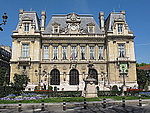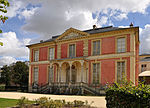Château de Neuilly
Châteaux in Hauts-de-SeineJuly MonarchyRoyal residences in France

The château de Neuilly is a former château in Neuilly-sur-Seine, France. Its estate covered a vast 170-hectare park called "parc de Neuilly" which comprised all of Neuilly that is today to be found between avenue du Roule and the town of Levallois-Perret. The castle was built in 1751, and was largely destroyed in 1848. One wing of the former castle remains, and was integrated into a new convent building in 1907.
Excerpt from the Wikipedia article Château de Neuilly (License: CC BY-SA 3.0, Authors, Images).Château de Neuilly
Boulevard du Général Leclerc, Arrondissement of Nanterre
Geographical coordinates (GPS) Address Phone number Website Nearby Places Show on map
Geographical coordinates (GPS)
| Latitude | Longitude |
|---|---|
| N 48.89 ° | E 2.2627 ° |
Address
Centre hospitalier Rives de Seine - Neuilly-sur-Seine (Hôpital de Courbevoie-Neuilly)
Boulevard du Général Leclerc
92200 Arrondissement of Nanterre
Ile-de-France, France
Open on Google Maps







